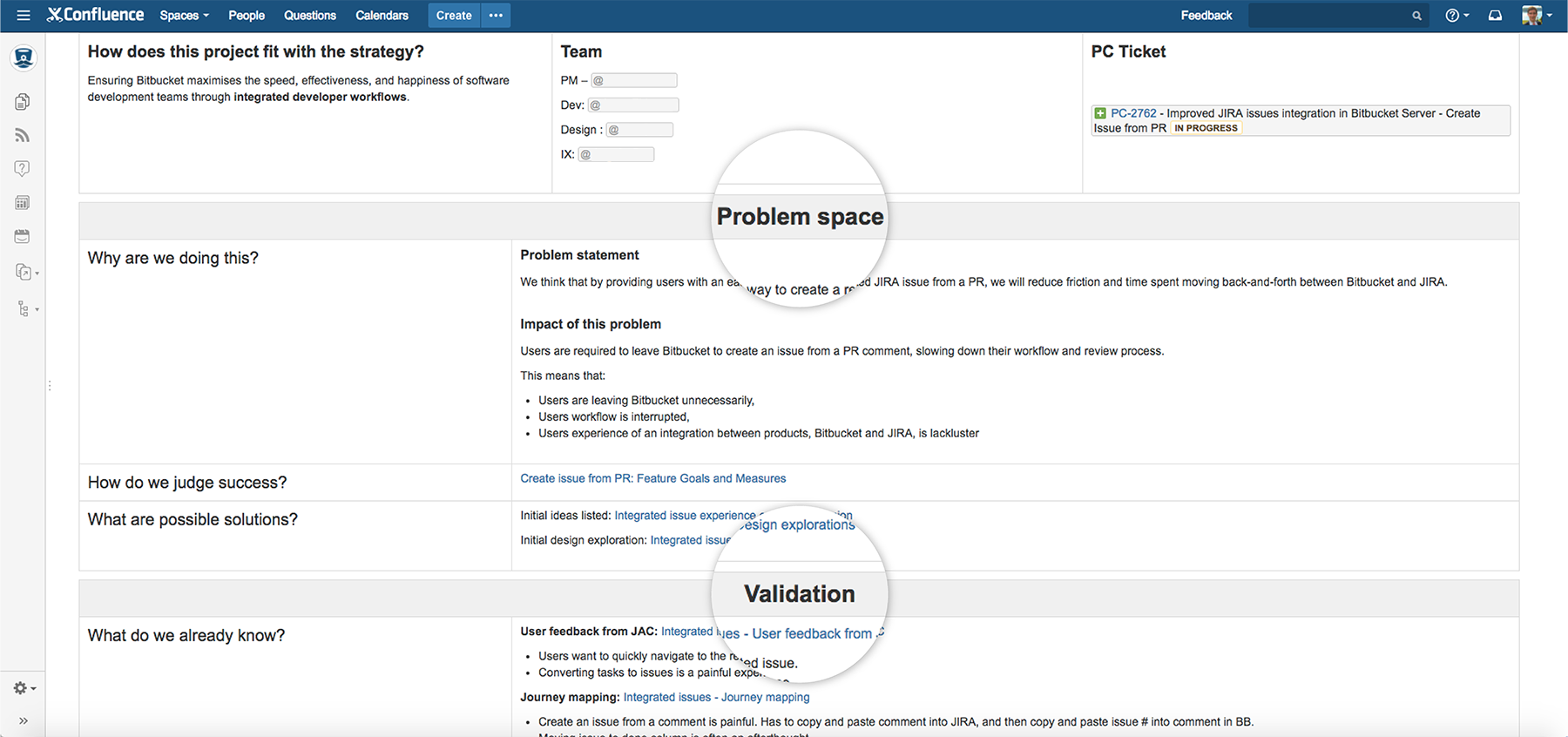Most conversations about DevOps focus on automation, and for good reason. Automation provides opportunities to significantly cut costs and eliminate human error from otherwise monotonous tasks. However, DevOps begins with a culture shift, in which the fundamental element is effective communication between development and operations teams.
Because automation provides for faster, more frequent deployments, having a collaborative, high-trust environment is more important than ever. Without such an environment, teams can stagnate. Or worse, fall into the trap of self-censoring and revert back to siloization, defeating the very purpose of DevOps.
So how can your team improve the way you communicate? What tools are at your disposal, and how do these tools help everyone stay on the same page and get work done on time? If you’re a Confluence user, the answer is right in front of you.
Confluence can be many things. It can serve as a launchpad for projects. It can serve as a tool to facilitate whatever your team is trying to do. But most importantly, it can serve as a central collaboration tool. Let’s look at how DevOps-minded teams can use Confluence to keep work flowing, incorporate continuous feedback, and create a jumping-off point for experimentation.
Best pages for facilitating flow
Flow refers to the coordination of work moving through the value stream, from the product owner to development to operations, and, ultimately, to customers. When projects are slowed down by having to throw work “over the wall” and back again, the best answer is to break down that wall and convey the collective goal for teams to work towards. Flow is an integral part of a successful DevOps relationship, and there are many ways in which teams use Confluence to maximize flow. For example…
1: Project posters
Our busy work days make it hard to see the forest for the trees. Establishing a shared understanding of the goal ahead is another way that Confluence contributes to a DevOps culture, specifically through project posters. With project posters, everyone involved can see the reason the project is being pursued, the way the project’s success will be judged, what information you already have, and what you need answers for. Simply put, communication is way easier when everyone involved in the project is a stakeholder with visibility on the greater goal.
We’re so big on these, we built a Confluence page template for project posters you can download (free!) from the Atlassian Marketplace.
2: Planning pages
In its infancy, a project can be a haphazard thing. Especially when combining tasks from different teams and consolidating information from loads of different sources. As a DevOps-minded team, you need to establish organization and define goals in a central place during the initial phases. At the same time your need fluidity to stay in sync with the continuous evolution of a project.
Think of Confluence as your blank canvas. You can formulate a project roadmap from scratch, share high-level statuses and deadlines with all teams involved, and ensure that corresponding tickets and child pages are housed under one roof. Plus, your page is flexible enough to accommodate all the adjustments that occur in the early stages of a project, making it easier to collaborate in real time and stay on the same page (literally).
#Poll: What do you think is the key to building #DevOps culture?
— Atlassian (@Atlassian) August 17, 2017
Best pages for improving peer feedback
Encouraging feedback – not just from systems like continuous integration, but also from team experiences and customers – is a tenet of DevOps. As a part of that, establishing a culture that discourages pointing fingers will help make team members more comfortable with a continuous feedback loop. Feedback should always be a mechanism for learning, as well as an open conversation.
Using Confluence pages to capture feedback ensures it’s transparent and doesn’t obstruct your team’s ability to communicate. (Not to mention the fact that putting feedback in writing, with our names attached, reminds us to be constructive!
3: Post-incident reviews and retrospectives
When reviewing an incident, the main goal is to understand what exactly went wrong, and how to make sure it doesn’t happen again. Similar to post-incident reviews (PIRs), retrospective pages lets your team look back to see what worked and what didn’t. However, whereas a PIR looks at a particular incident, retrospectives serve as a loose reflection of the team’s performance holistically. Together, these two types of Confluence pages help encourage communication by following pre-defined structures that help keep feedback focused and productive.
And in case you’re wondering, yes: there’s a Confluence page template for retrospectives, too.
4: Health monitors
No team is perfect, but that doesn’t mean you should be complacent. Health monitors are your team’s chance to listen to each other and take an honest look in the mirror. You’ll assess your team against eight attributes common among high-performing teams, and walk away with a plan to address your weak spots.
[slideshare id=95605688&doc=atlassianteamhealthmonitorshowtoguide-180501154000]
Like a number of other plays from the Atlassian Team Playbook, there’s a Confluence page template for the Health Monitor. (These page templates are often referred to as “blueprints”, by the way.)
If you’re wondering… the Team Playbook is a collection of techniques (“plays”) our teams use to be more effective. We put them all in a website, which is available for all teams to use – even if you’re not a customer.
Best pages for encouraging experimentation
Production environments aren’t static. They’re dynamic – almost living – things that are constantly evolving. Experimentation is vital in DevOps because taking risks and learning from failure are necessary steps in improving the various processes involved. Without a structure for monitoring experimentation, the outcome can be skewed by things like observational bias. Confluence can serve as a journal of sorts for these experiments, and help teams know that what they’re designing is realistic and resourced properly.
Create a culture that fosters two things: continual experimentation, which requires taking risks and learning from success and failure; and understanding that repetition and practice is the prerequisite to mastery.
–Gene Kim, co-author of “The DevOps Handbook” and “The Phoenix Project”
5: Experiment definitions, targets, and results
Similar to planning pages or dashboards, Confluence can be a centralized space where your team is able to define experiments, convey their targets for the experiment and evaluate them against the results. The ultimate application of these pages can help teams be decisive when tweaking the process and eliminate potential disagreements among team members.
Best pages for team-building
For all the focus on automation and metrics, DevOps is a very humanized way of working. It relies on trust, empathy, and respect. But humans don’t necessarily connect with each other in those ways at the first handshake. It takes time. And Confluence can help.
6: Introduction blogs
A big part of DevOps is team building. One way teams can do that is to build out pages that promote team interaction, like an introduction blog when new members join the team. Intro blogs give team members the opportunity to showcase their personality, spark conversations with others, and strengthen the overall DevOps community. Check out my personal intro blog below!
7: (bonus!) Just-for-fun pages
At Atlassian, teams use pages in all sorts of goofy ways. We share pictures from our vacations, keep running lists of must-binge TV shows, organize ping-pong tournaments, and call out each other’s celebrity look-alikes. And because these pages are in Confluence, we can get the whole department – or the whole company – in on the action.
Because the team that plays together stays together.
Breaking down the walls for good
Working as a team is really hard, and tools alone won’t fix that. There needs to be an underlying culture that supports the team and how they work together. DevOps aims to achieve increased efficiency and coordination while limiting individual blame, and to get there, teams need frequent communication in a common space.
On the surface, Confluence is like a whiteboard. But let’s face it, whiteboards get messy. When structure is brought into the picture through features such as macros or plays, Confluence helps keep things tidy and organized. In a DevOps culture, Confluence ensures the line of communication on projects is wide open by keeping everyone in the loop and focused on the greater task at hand.
And that communication goes to the very core of DevOps culture: breaking down the walls that block collaboration.
. . .
Haven’t tried Confluence yet? Take a tour and start your team on the path to a stronger DevOps culture.

